

A good aquarium air stone or bubbler should produce a fine stream of small bubbles over its entire surface at all flow rates. This page chronicles the results of seeing which, if any, of the following air stones accomplish this:

First up we have the cheapest air stones: Petsmart's Great Choice ($1.29), a local aquarium shop's Dynamic Reef (2 for $2.99), Aqua-Mist (2 for $1.79), Walmart's Aqua Culture by Penn Plax (2 for $1.38) and finally Petco's brand (2 for $.99.)
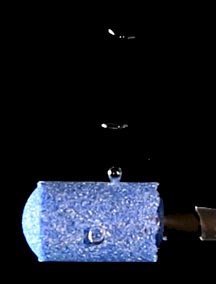
The Aqua Culture stones are good representatives of this class. Made of sintered glass, at low flow rates bubbles emerge from the largest and shortest channels formed during manufacture.
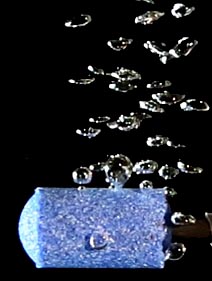
At higher glow rates the pressure is great enough to force air through smaller pores. Notice that very little of the bubbler's surface is actively producing bubbles. Non-uniform bubble production turned out to be a common fault of all air stones of similar construction, regardless of their size or cost. Bubbles from such air stones typically start off 0.10 inches in diameter and are quickly flattened to pancake shaped disks 0.16 inches in diameter by fluid dynamic drag as they rise. This flattening is more obvious with small flow rates and is actually a good thing because it exposes more of the bubble's air to the water than if it were spherical. If the flow is heavy enough, the bubbles create an upward water current that helps them retain some of the spherical shape surface tension wants them to have.
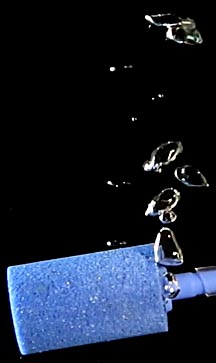
Another common problem with all air stones of this type is poor sealing of the inlet, which causes leaks as the image above shows. Both of the Dynamic Reef bubblers had this problem.
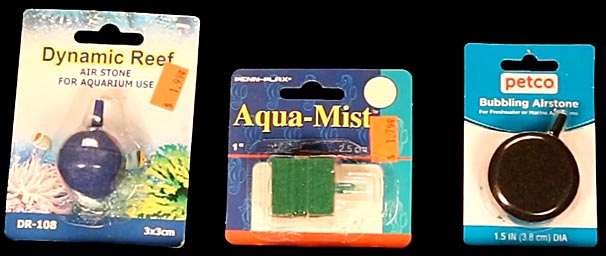
The next size up consists of slightly larger air stones with bulkier shapes. In this set I tested the Dynamic Reel spherical bubbler ($1.99), the Aqua-Mist cube ($1.79) and the Petco disk ($1.99).
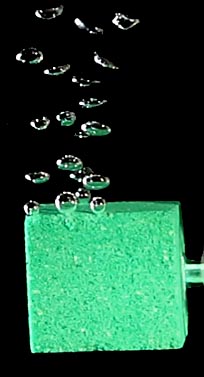
They all worked the same as the Aqua-Mist cube: uneven distribution of medium large (0.10 inch) bubbles.
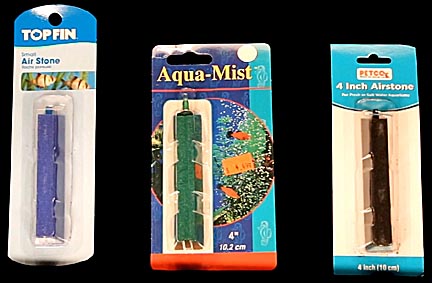
Four-inch long bar shaped air stones made with the same sintered glass technology worked no better than any of the previous bubblers. The Topfin from from Petsmart cost $2.49, Walmart's Aqua-Mist was $4.49 and the Petco model was $1.99.
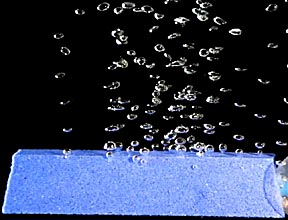
Again, they all produced average sized bubbles over a small percent of their total area. None of the three tested worked better than the others, so a choice could be made based on color or price.
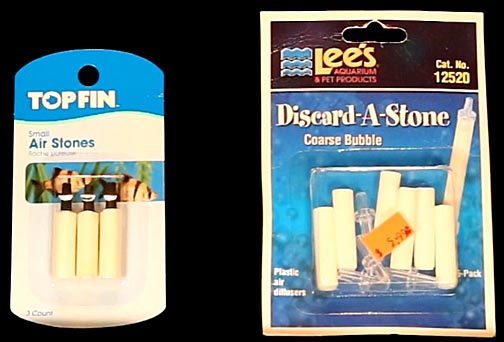
The small Topfin bubbler above from Petsmart (3 for $2.99) appeared to be made from sintered ceramic or sand and had a much finer texture than any of the previous stones. Lee's Discard-a-Stones from Amazon (6 for 5.99) were permeable plastic.
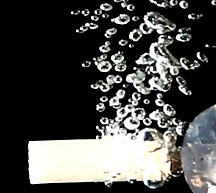
The Topfin produced very slightly smaller than average bubbles, but from only half of its length.

In addition to producing the largest, coarsest bubbles of any air stone tested, the Discard-a-Stone also leaked badly from where the inlet tube is pushed into the plastic stone.
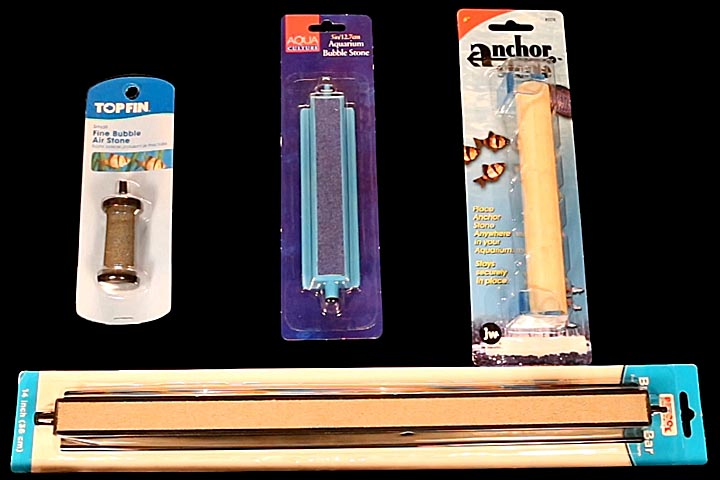
The next class of bubblers are those with more of a supporting framework. Petsmart's 2 inch cylindrical Topfin air stone was $2.99, Walmart's Aqua Culture 5 inch flat bubbler was $1.78, the Anchor 6 inch bubbler $6.99 and the 14 inch Petco bubbler was $5.99.
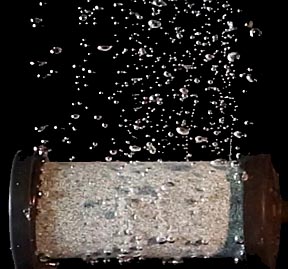
Although the Topfin air stone leaked slightly around the rims of the two end caps, the rest of this bubbler produced the smallest bubbles so far evenly distributed over its entire surface. Many of the bubbles started out less than 0.015 inches in diameter. This is important because the smaller the bubble size the greater the total amount of surface area is exposed to the water for a given volume of air, which increases gas transfer efficiency. This was the first air stone whose performance impressed me. A little epoxy around the end caps would solve the leak problem.
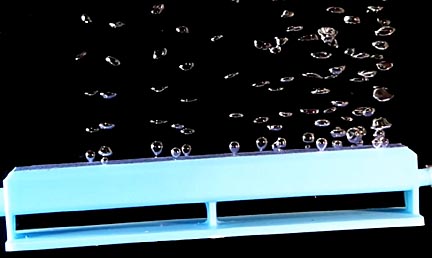
The Aqua Culture flat stone produced larger than average bubbles and didn't release them evenly over its surface. Walmart's 14 inch long flat stone was even worse.
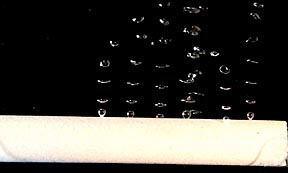
The worst of all was the Anchor stone, which used less than half of its surface area even at high flow rates.
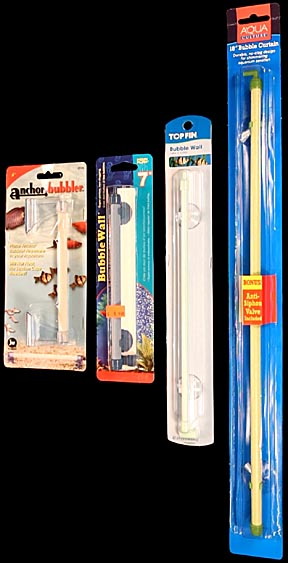
Bubble wall systems are popular because they create an attractive curtain of bubbles. The Anchor 6 inch from Petco was $3.99, the 7 inch Penn Plax from the local aquarium store was $9.99, the 10 inch Topfin from Petsmart was $4.49 and the 14 inch Walmart Aqua Culture was $5.42.
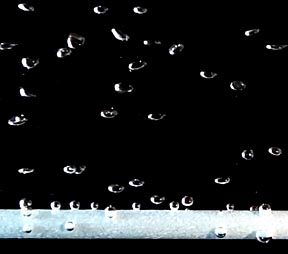
The Topfin, Aqua Culture and Anchor all produced average sized bubbles fairly evenly over their entire lengths, with the exception of the anchor, which had short dead zones near both ends.
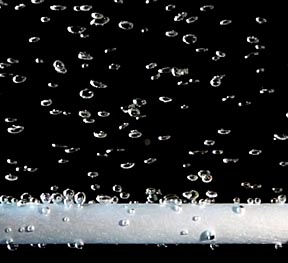
The Penn Plax did the best, producing fairly small 0.07 inch diameter spherical bubbles uniformly over its entire surface. I rate this one just under the Topfin 2 inch cylindrical bubbler.
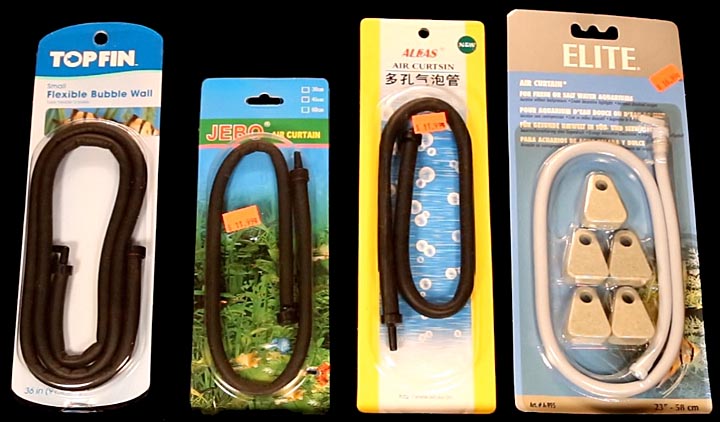
Many hobbyist like flexible bubble curtains because they can be shaped to follow the aquarium's contours. The 36 inch Topfin cost $13.69, the 18 inch JEBO was $11.99, the 18 inch Aleas $11.99 and the 23 inch long ELITE curtain was $16.99.
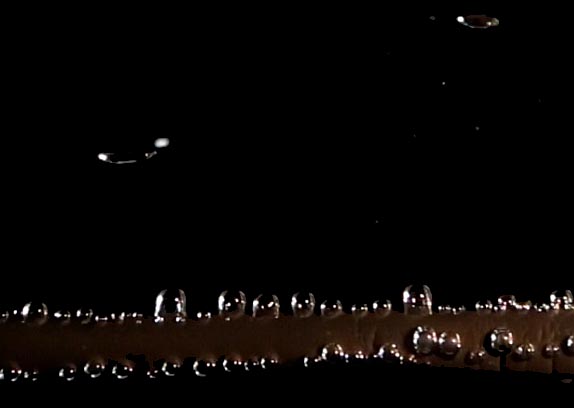
The first three all worked the same. They were stiff enough to hold their shape and heavy enough to remain on the bottom without weighting. Bubbles are released from a double row of fine pinpricks along their lengths. Bubble production was uniform but the bubbles tended to be very large. The ELITE was the worse. It's tube is so soft and flexible that it can't shaped. It's also very buoyant necessitating using the five weights provided to keep it down. Unlike the first three, the sides are permeable so bubbles are released from the entire surface. If one end of the tube is higher than the rest, most of the air will be released from it. The other flexible bubblers didn't have this problem to as great a degree.
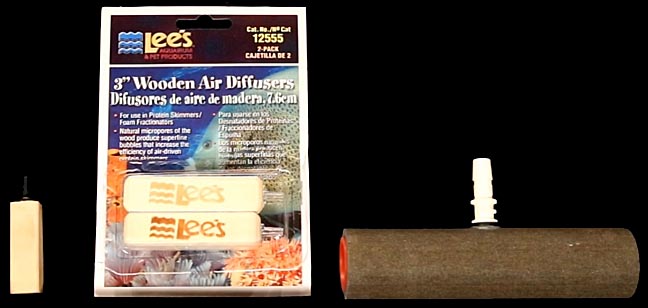
The last two types of air stones are wood blocks and the Mirco-Pore brand of pond aerators. The first is a 2 inch unnamed bubbler from a local aquarium store ($5.99), next is Lee's 3 inch long blocks from Amazon (2 for $6.00) and lastly a 6 inch Micro Pore Hog, also from Amazon for $35.00.
 ..................
..................
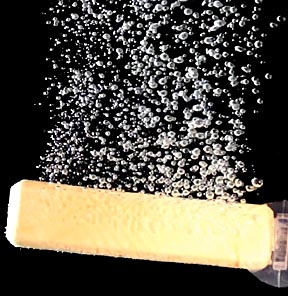
At all flow rates the wood block bubblers produced the finest bubbles, as little as 0.007 inches in diameter. Because the bubbles are created by air leaking out through the end grain of the wood, they are released on opposite sides. For this reason these air stones work best if the two active surfaces are vertical. If one faces down the bubbles on that side will coalesce into much larger bubbles. One downside to using wood block bubblers is that mold and fungus tend to start growing on them after two weeks. Another problem is that cracks can form in them as they dry out on the store's shelves.
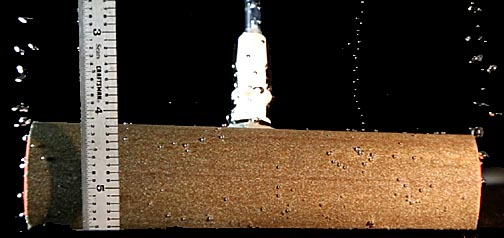
Although the Micro Pore stone leaked slightly around the end caps...
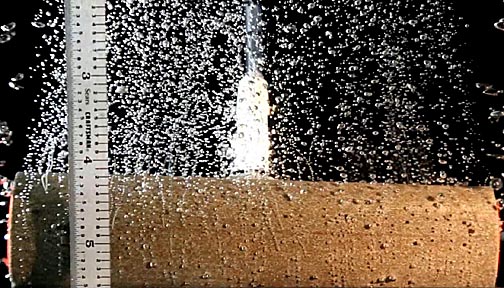
... it produced bubbles almost as fine as the wood blocks very evenly over its entire surface.
Conclusions:
For the average aquarium, wood block bubblers are the clear winners as far as producing the finest bubbles. The Micro Pore bubbler is almost as good and more durable, but its size and cost make it less attractive. Close to these is the Topfin 2 inch long cylindrical fine bubbler. Lastly, the Penn Plax 7-inch bubble wall is a cost effective, widely available option. For visitors wishing to see all of the air stones tested on this page in action, please click on the following YouTube video:
I sincerely hope you found this page useful. Thank you for visiting.
Return to my main page to browse 60 other subjects